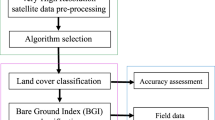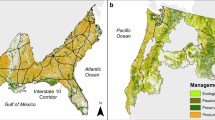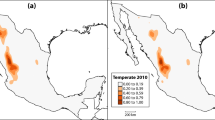Abstract
We used geographic information system applications and statistical analyses to classify young, premature forest areas in southeastern Georgia using combined data from Landsat TM 5 satellite imagery and ground inventory data. We defined premature stands as forests with trees up to 15 years old. We estimated the premature forest areas using three methods: maximum likelihood classification (MLC), regression analysis, and k-nearest neighbor (kNN) modeling. Overall accuracy (OA) of classifying the premature forest using MLC was 82% and the Kappa coefficient of agreement was 0.63, which was the highest among the methods that we have tested. The kNN approach ranked second in accuracy with OA of 61% and a Kappa coefficient of agreement of 0.22. Regression analysis yielded an OA of 57% and a Kappa coefficient of 0.14. We conclude that Landsat imagery can be effectively used for estimating premature forest areas in combination with image processing classifiers such as MLC.




Similar content being viewed by others
References
Altman NS (1992) An introduction to kernel and nearest-neighbor nonparametric regression. Am Stat 46(3):175–185
Berndes G, Bird N, Cowie A (2011) Bioenergy, Land Use Change and Climate Channge Mitigation. Background technical report. IEA Bioenergy ExCo:2011:04, Rotorua, New Zealand
Boyd DS, Foody GM, Ripple WJ (2002) Evaluation of approaches for forest cover estimation in the Pacific Northwest, USA, using remote sensing. Appl Geogr 22:375–392
Brown S, Lugo AE (1990) Tropical secondary forests. J Trop Ecol 6(01):1–32
Chen XF, Chen JM, An SQ, Ju WM (2007) Effects of topography on simulated net primary productivity at landscape scale. J Environ Manag 85:585–596
Cohen WB, Spies TA, Fiorella M (1995) Estimating the age and structure of forests in a multi-ownership landscape of western oregon, USA. Int J Remote Sens 16:721–746
Congalton RG (1991) A review of assessing the accuracy of classifications of remotely sensed data. Remote Sens Environ 37:35–46
Congalton RG, Green K (2008) Assessing the accuracy of remotely sensed data: principle and practices. CRC Press, Boca Ralton
Crookston NL, Finley A (2008) yaImpute: An R package for k-NN imputation. J Stat Softw. https://www.jstatsoft.org/article/view/v023i10
Faaij AP (2006) Bio-energy in Europe: changing technology choices. Energy Policy 34:322–342
Foody GM (2002) Status of land cover classification accuracy assessment. Remote Sens Environ 80:185–201
Foody GM, Palubinskas G, Lucas RM, Curran PJ, Honzak M (1996) Identifying terrestrial carbon sinks: classification of successional stages in regenerating tropical forest from Landsat TM data. Remote Sens Environ 55:205–216
Franco-Lopez H, Ek AR, Bauer ME (2001) Estimation and mapping of forest stand density, volume, and cover type using the k-nearest neighbors method. Remote Sens Environ 77(3):251–274
Franklin SE, Wulder MA, Skakun RS, Carroll AL (2003) Mountain pine beetle red-attack forest damage classification using stratified Landsat TM data in British Columbia, Canada. Photogramm Eng Remote Sens 69(3):283–288
Hunter M (2001) Management in young forests. Cascade Center for Ecosystem Management Communique 3. USDA Forest Service
Jackson RD, Slater PN, Pinter PJ Jr (1983) Discrimination of growth and water stress in wheat by various vegetation indices through clear and turbid atmospheres. Remote Sens Environ 13:187–208
Kim H, Bettinger P, Cieszewski C (2012) Reflections on the estimation of stand-level forest characteristics using Landsat satellite imagery. Appl Remote Sens J 2:45–56
Labrecque S, Fournier RA, Luther JE, Piercey D (2006) A comparison of four methods to map biomass from Landsat-TM and inventory data in western Newfoundland. For Ecol Manag 226:129–144
Lawson CL, Hanson RJ (1974) Solving least squares problems, vol 161. Prentice-hall, Englewood Cliffs
Li G, Lu D, Moran E, Hetrick S (2011) Land-cover classification in a moist tropical region of Brazil with Landsat Thematic Mapper imagery. Int J Remote Sens 32(23):8207–8230
Lillesand TM, Kiefer RW, Chipman JW (2008) Remote sensing and image interpretation, 6th edn. Wiley, Hoboken
Liu W, Song C, Schroeder TA, Cohen WB (2008) Predicting forest successional stages using multitemporal Landsat imagery with forest inventory and analysis data. Int J Remote Sens 29(13):3855–3872
Lu D, Mausel P, Brondízio E, Moran E (2004) Relationships between forest stand parameters and Landsat TM spectral responses in the Brazilian Amazon Basin. For Ecol Manag 198:149–167
Mäkelä H, Pekkarinen A (2004) Estimation of forest stand volumes by Landsat TM imagery and stand-level field-inventory data. For Ecol Manag 196:245–255
Ohmann JL, Gregory MJ (2002) Predictive mapping of forest composition and structure with direct gradient analysis and nearest-neighbor imputation in coastal Oregon, USA. Can J For Res 32(4):725–741
Powell SL, Cohen WB, Healey SP, Kennedy RE, Moisen Pierce KB, Ohmann JL (2010) Quantification of live aboveground forest biomass dynamics with Landsat time-series and field inventory data: a comparison of empirical modeling approaches. Remote Sens Environ 114(5):1053–1068
Reese H, Nilsson M, Sandstr P, Ha Olsson (2002) Applications using estimates of forest parameters derived from satellite and forest inventory data. Comput Electron Agric 37:37–55
Reese H, Nilsson M, Pahlen TG, Hagner O, Joyce S, Tingelof U, Egberth M, Olsson H (2003) Countrywide estimates of forest variables using satellite data and field data from the national forest inventory. Ambio 32:542–548
Richards JA (1999) Remote sensing digital image analysis. Springer, Berlin
Ros JPM, van Minnen JG, Arets EJMM (2013) Climate effects of wood used for bioenergy. PBL Publication number: 182, Alterra Report: 2455. PBL Netherlands Environmental Assessment Agency, The Jague/Bilthoven, The Netherlands
Rosenfield GH, Fitzpatrick-Lins K (1986) A coefficient of agreement as a measure of thematic classification accuracy. Photogramm Eng Remote Sens 52:223–227
Rosson JFJ, Rose AK (2010) Arkansas’ forests, 2005. US Department of Agriculture, Forest Service, Southern Research Station, Asheville, North Carolina Resource Bulletin SRS-166
Rouse JW, Haas RH, Schell JA, Deering DW (1973) Monitoring vegetation systems in the great plains with ERTS. Third ERTS Symposium. NASA SP-351 I:309–317
Sellers PJ (1985) Canopy reflectance, photosynthesis and transpiration. Int J Remote Sens 6:1335–1372
Song C, Woodcock CE, Seto KC, Lenney MP, Macomber SA (2001) Classification and change detection using Landsat TM data: when and how to correct atmospheric effects? Remote Sens Environ 75:230–244
Steininger MK (2000) Satellite estimation of tropical secondary forest above-ground biomass: data from Brazil and Bolivia. Int J Remote Sens 21:1139–1157
Story M, Congalton R (1986) Accuracy assessment: a user’s perspective. Photogramm Eng Remote Sens 52:397–399
Tokola T, PitkÄNen J, Partinen S, Muinonen E (1996) Point accuracy of a non-parametric method in estimation of forest characteristics with different satellite materials. Int J Remote Sens 17:2333–2351
Tomppo EO, Gagliano C, De Natale F, Katila M, McRoberts RE (2009) Predicting categorical forest variables using an improved k-Nearest Neighbour estimator and Landsat imagery. Remote Sens Environ 113(3):500–517
Tortora RD (1978) A note on sample size estimation for multinomial populations. Am Stat 32:100–102
Tucker CJ (1979) Red and photographic infrared linear combinations for monitoring vegetation. Remote Sens Environ 8:127–150
USDA Forest Service (2015) Forest Inventory and Analysis National Program. Available at http://www.fia.fs.fed.us Accessed 07 Sept 2015
Zheng G, Chen JM, Tian Q, Ju WM, Xia XQ (2007) Combining remote sensing imagery and forest age inventory for biomass mapping. J Environ Manag 85:616–623
Acknowledgements
This work was in part supported by a Georgia TIP-3 Fiber Supply Assessment grant. Special thanks to Dr. Pete Bettinger for his valuable advices in all aspects of the work.
Author information
Authors and Affiliations
Corresponding author
Additional information
Project funding: This work was in part supported by a Georgia TIP-3 Fiber Supply Assessment grant.
The online version is available at http://www.springerlink.com
Corresponding editor: Yu Lei.
Rights and permissions
About this article
Cite this article
Kim, H., Cieszewski, C.J. & Lowe, R.C. Estimation of premature forests in Georgia (USA) using U.S. Forest Service FIA data and Landsat imagery. J. For. Res. 28, 1249–1260 (2017). https://doi.org/10.1007/s11676-017-0389-4
Received:
Accepted:
Published:
Issue Date:
DOI: https://doi.org/10.1007/s11676-017-0389-4




